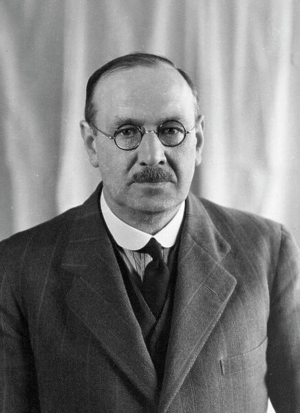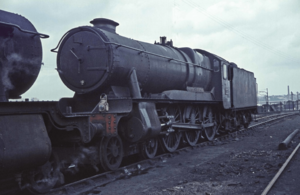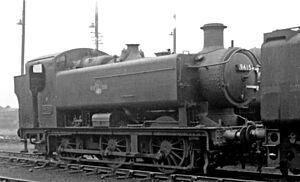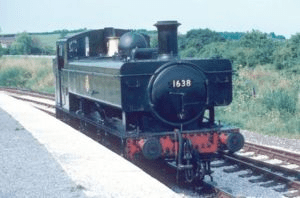Frederick Hawksworth facts for kids
Quick facts for kids
Frederick Hawksworth
|
|
|---|---|

Hawksworth in 1943
|
|
| Born | 10 February 1884 Swindon, England
|
| Died | 13 July 1976 (aged 92) Swindon, England
|
| Nationality | British |
| Education | Apprentice Swindon Works |
| Occupation | Engineer |
| Engineering career | |
| Discipline | Mechanical Engineering |
| Employer(s) | Great Western Railway |
| Significant design | County Class, Modified Hall Class, 9400 Class |
Frederick William Hawksworth (born February 10, 1884 – died July 13, 1976) was a very important engineer. He was the last Chief Mechanical Engineer (CME) for the Great Western Railway (GWR) in Great Britain. This means he was in charge of designing and building all their trains.
Contents
Starting His Career
Frederick Hawksworth worked his whole life at the Swindon Works for the GWR. He started there in 1898 when he was 15 years old, as an apprentice. An apprentice learns a trade by working with experienced people.
In 1905, he became an apprentice draughtsman. This meant he helped draw the plans for new trains. He worked under a famous engineer named George Jackson Churchward. Hawksworth was one of Churchward's "Bright Young Men." He helped with the designs for amazing trains like "The Great Bear".
After Churchward retired in 1921, Hawksworth became the Chief Draughtsman. He helped design the powerful King Class trains. Later, in 1932, he became an Assistant to the Chief Mechanical Engineer. He then became the Principal Assistant. Hawksworth also helped make the train testing area at Swindon more modern. This helped improve how trains were tested across Britain.
Becoming Chief Mechanical Engineer
Hawksworth became the Chief Mechanical Engineer (CME) in 1941. This was a very important job. He continued the design style he had learned, but he also made some big improvements. For example, he added more powerful superheaters to larger trains. Superheaters make steam hotter, which gives the engine more power.
His team also started using more welding to build trains. This made the trains stronger and look smoother. He also designed new tenders (the part of the train that carries coal and water) with smooth, welded sides.
Modified Hall Class Trains
His first new train design was the Modified Hall class. These trains started being built in 1944. They were an improved version of an older design. They had better superheaters and a different way of building their engines and frames.
County Class Trains
After World War II, Hawksworth designed four more new types of trains. The 'County' Class was a powerful 4-6-0 type train. It was the last and strongest GWR train with two cylinders. Its design was similar to the Modified Hall, but it had a new, larger boiler. This boiler used parts from other trains built during the war. It also used a higher steam pressure than any GWR boiler before. These trains were named after counties, just like some older GWR trains.
9400 Class Trains
The 9400 Class trains were 0-6-0 pannier tank engines. Many of these were built by other companies. They looked similar to an older class of trains, but they had a much bigger boiler. This gave them more power and better braking. Only the first ten of these trains were built by the GWR itself. The rest were built for British Railways.
1500 Class Trains

One of his most different designs was the 1500 Class. It used the same boiler as the 9400 class. But it had a completely new, shorter frame and used a lot of welding. These trains were made to be easy to fix and maintain.
1600 Class Trains
The last train Hawksworth designed was the 1600 Class. This was a lighter 0-6-0 pannier tank train. It was a modern version of an older train class that was getting too old to use.
Other Projects
Hawksworth also worked on trying to make trains run on oil instead of coal between 1946 and 1950. This was because coal was being sent to other countries after the war. However, this project stopped when oil became too expensive. He also helped order GWR diesel shunters and two experimental Gas turbine-electric locomotives.
Hawksworth had also planned to build a very large "Pacific" type train for the GWR. This train was called the "Cathedral Class." However, this design was never actually built.
Working for British Railways
Hawksworth continued as Chief Mechanical Engineer when the Western Region of British Railways was formed in 1948. He kept working on train designs until he retired at the end of 1949.
Later Life and Legacy
After retiring, Hawksworth was the chairman of the Swindon magistrates (local judges) from 1951 to 1959. He was honored as a "freeman" of the borough of Swindon in 1960. He passed away in Swindon in July 1976. His ashes are buried near the old Swindon Works.
Preserved Trains
Many of Hawksworth's train designs have been saved and preserved. This means they are kept in good condition, often for museums or special train rides. All of his designs, except the 'Counties', still exist today. The Great Western Society is even building a new 'County' train, a copy of No.1014 County of Glamorgan. They are using parts from other old trains to build it.
Some of his preserved trains include:
- 'Modified Halls': No.6960 Raveningham Hall, No.6984 Owsden Hall, No.6989 Wightwick Hall, No.6990 Witherslack Hall, No.6998 Burton Agnes Hall, and No.7903 Foremarke Hall.
- '9400' pannier tanks: No.9400 and No.9466.
- '1500' class: No.1501.
- '1600' class: No.1638.
Some of these trains were almost scrapped (taken apart for metal) at a place called Barry Scrapyard. But luckily, they were saved and restored!
See also
- Locomotives of the Great Western Railway#Frederick Hawksworth (1941-1949) § Notes
- List of GWR standard classes with two outside cylinders
Hawksworth’s Locomotive Designs





